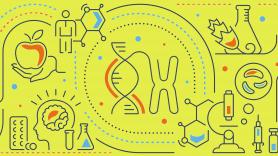Panel discussion 2: Ethics, philosophy and scientific responsibility
In the 1997 film Gattaca, parents can choose their unborn child’s genetic characteristics, giving rise to potentially ‘superior’ individuals, with all the ethical debates that come with that. Are we there yet?
“It’s no longer just a film, these things are already happening in some parts of the world,” said Lluís Montoliu, a researcher at the Spanish National Center for Biotechnology in Madrid, and one of the foremost CRISPR experts in Spain. Montoliu spoke of two genome-edited girls born in China and the announcement around the same time that something similar could happen in Russia (which led to widespread criticism from various associations). He then made it clear that he was just being provocative, because “we aren’t really there yet. Just for eye color we would have to take multiple genes into account.” We aren’t ready for that sort of ‘designs’ yet, but what seems clear is that “it’s hard to be both emotional and pragmatic here,” said Marc Güell, a researcher at Pompeu Fabra University and one of the leaders of this B·Debate session.
“The main question we will have to answer is what do we want?” said Sonja Erikainen, researcher at the Centre for Health, Technologies and Social Practice at the University of Leeds. Because “many times it’s hard to distinguish between a treatment and an improvement. Preventing a disease, for example: is that an improvement or a treatment?” Montoliu believes this issue is so complicated that we will probably have to study it on a case-by-case basis, but he is sure that “when we talk about improvements, it’s generally a euphemism for eugenics.” This doesn’t mean that times aren’t changing: the lines are blurring in some cases and one day we will surely have to consider some of these possibilities.
Montoliu warned of several dangers that haven’t yet been resolved. For example, no one is monitoring who buys the CRISPR tools. Also in terms of safety: what are known as off-target effects (cuts in unintended locations of the DNA) can be contained more or less, but less is made of on-target effects, which are undesired mutations in the right cut spot caused because we don’t fully control the repair mechanisms yet. “This is less important in the lab. If we experiment with 20 mice, we can choose the one that comes out right. But we can’t do that with embryos in real life.”
Pere Estupinyá, the moderator for the panel, put forth a question: Then, when will the time come? That question is very broad, ranging from modifying embryos to different types of therapies in adults. Some of them are already in the clinical trials phase, but generally in very specific areas like the eyes or modifying cells in the lab, not in vivo. Montoliu is clear: “when it’s safe.” But there is also room for debate here. Erikainen believes we have to consider the patient’s right to treatment when there is no other option, which could also affect the feasibility of clinical trials, which require a group of patients who aren’t administered the drug in order to establish its efficacy. “I don’t have the answers, but I do think that we have to ask ourselves these ethical questions,” he noted.
And this one, too: the question of price, which in most cases are astronomical today, with therapies costing around €500,000 per patient. “Now we’re in the fireworks stage, but I’m sure they will drop dramatically,” said Montoliu. “It’s a question of negotiation, and governments should be part of it.”



